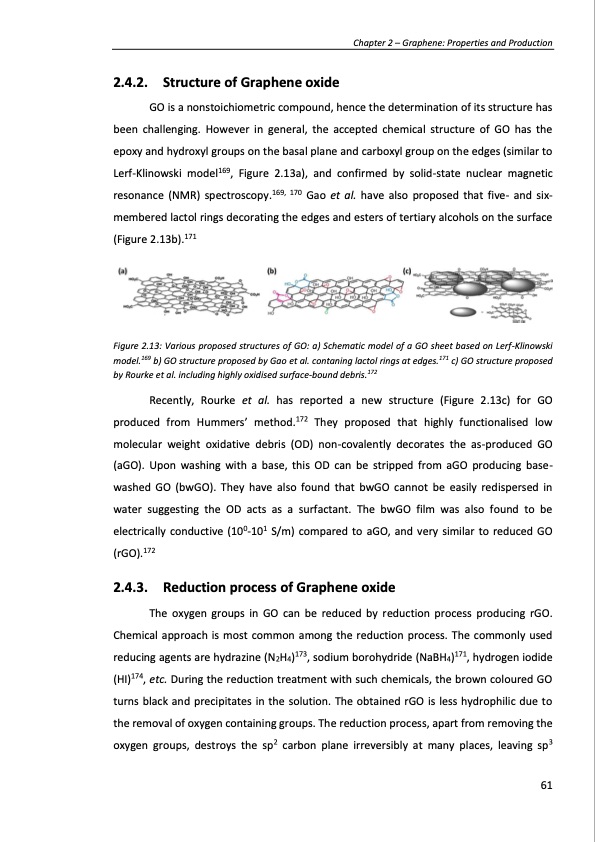
PDF Publication Title:
Text from PDF Page: 061
2.4.2. Structure of Graphene oxide GO is a nonstoichiometric compound, hence the determination of its structure has been challenging. However in general, the accepted chemical structure of GO has the epoxy and hydroxyl groups on the basal plane and carboxyl group on the edges (similar to Lerf-Klinowski model169, Figure 2.13a), and confirmed by solid-state nuclear magnetic resonance (NMR) spectroscopy.169, 170 Gao et al. have also proposed that five- and six- membered lactol rings decorating the edges and esters of tertiary alcohols on the surface (Figure 2.13b).171 Figure 2.13: Various proposed structures of GO: a) Schematic model of a GO sheet based on Lerf-Klinowski model.169 b) GO structure proposed by Gao et al. contaning lactol rings at edges.171 c) GO structure proposed by Rourke et al. including highly oxidised surface-bound debris.172 Recently, Rourke et al. has reported a new structure (Figure 2.13c) for GO produced from Hummers’ method.172 They proposed that highly functionalised low molecular weight oxidative debris (OD) non-covalently decorates the as-produced GO (aGO). Upon washing with a base, this OD can be stripped from aGO producing base- washed GO (bwGO). They have also found that bwGO cannot be easily redispersed in water suggesting the OD acts as a surfactant. The bwGO film was also found to be electrically conductive (100-101 S/m) compared to aGO, and very similar to reduced GO (rGO).172 2.4.3. Reduction process of Graphene oxide The oxygen groups in GO can be reduced by reduction process producing rGO. Chemical approach is most common among the reduction process. The commonly used reducing agents are hydrazine (N2H4)173, sodium borohydride (NaBH4)171, hydrogen iodide (HI)174, etc. During the reduction treatment with such chemicals, the brown coloured GO turns black and precipitates in the solution. The obtained rGO is less hydrophilic due to the removal of oxygen containing groups. The reduction process, apart from removing the oxygen groups, destroys the sp2 carbon plane irreversibly at many places, leaving sp3 Chapter 2 – Graphene: Properties and Production 61PDF Image | PRODUCTION AND APPLICATIONS OF GRAPHENE AND ITS COMPOSITES

PDF Search Title:
PRODUCTION AND APPLICATIONS OF GRAPHENE AND ITS COMPOSITESOriginal File Name Searched:
graphene-production-applications.PDFDIY PDF Search: Google It | Yahoo | Bing
Salgenx Redox Flow Battery Technology: Power up your energy storage game with Salgenx Salt Water Battery. With its advanced technology, the flow battery provides reliable, scalable, and sustainable energy storage for utility-scale projects. Upgrade to a Salgenx flow battery today and take control of your energy future.
| CONTACT TEL: 608-238-6001 Email: greg@infinityturbine.com | RSS | AMP |